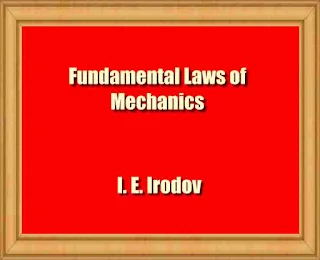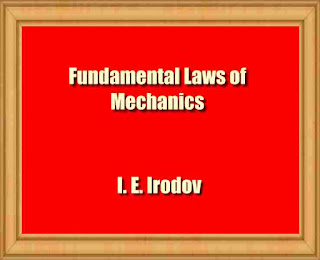Download Fundamental Laws of Mechanics- PDF book by I. E. Irodov
Fundamental Laws of Mechanics
From Introduction:
Mechanics is a branch of physics treating the simplest form of motion of matter, mechanical motion, that is, the motion of bodies in space and time. The occurrence of mechanical phenomena in space and time can be seen in any mechanical law involving, explicitly or implicitly, space-time relations, i.e. distances and time intervals.
The position of a body in space can be determined only with respect to other bodies. The same is true for the motion of a body, i.e. for the change in its position over time. The body (or the system of mutually immobile bodies) serving to define the position of a particular body is identified as the reference body.
For practical purposes, a certain coordinate system, e.g. the Cartesian system, is fixed to the reference body whenever motion is described. The coordinates of a body permit its position in space to be established. Next, motion occurs not only in space but also in time, and therefore the description of the motion presupposes time measurements as well.
This is done by means of a clock of one or another type. A reference body to which coordinates are fixed and mutually synchronized clocks form the so-called reference frame. The notion of a reference frame is fundamental in physics.
A space-time description of motion based on distances and time intervals is possible only when a definite reference frame is chosen. Space and time by themselves ' are also physical objects, just as any others, even though immeasurably more important.
The properties of space and time can be investigated by observing bodies moving in them. By studying the character of the motion of bodies we determine the properties of space and time. Experience shows that as long as the velocities of bodies are small in comparison with the velocity of light, linear scales and time intervals remain invariable on the transition from one reference frame to another, i.e. they do not depend on the choice of a reference frame.
This fact finds expression in the Newtonian concepts of absolute space and time. Mechanics treating the motion of bodies in such cases is referred to as classical. When we pass to velocities comparable to that of light, it becomes obvious that the character of the motion of bodies changes radically. Linear scales and time intervals become dependent on the choice of a reference frame and are different in different reference frames.
Mechanics based on these concepts are referred to as relativistic. Naturally, relativistic mechanics is more general and becomes classical in the case of small velocities. The actual motion characteristics of bodies are so complex that to investigate them we have to neglect all insignificant factors, otherwise, the problem would get so complicated as to render it practically insoluble.
For this purpose notions (or abstractions) are employed whose application depends on the specific nature of the problem in question and on the accuracy of the result that we expect to get. A particularly important role is played by the notions of a mass point and of a perfectly rigid body. A mass point, or, briefly, a particle, is a body whose dimensions can be neglected under the conditions of a given problem. It is clear that the same body can be treated as a mass point in some cases and as an extended object in others.
A perfectly rigid body, or, briefly, a solid, is a system of mass points separated by distances that do not vary during its motion. A real body can be treated as a perfectly rigid one provided its. deformations are negligible under the conditions of the problem considered.
The objective of the book is to draw the readers' attention to the basic laws of mechanics, that is, to the laws of motion and to the laws of conservation of energy, momentum and angular momentum, as well as to show how these laws are to be applied in solving various specific problems.
At the same time, the author has excluded all things of minor importance in order to concentrate on the questions which 'j^re the hardest to comprehend. The book consists of two parts:
(1) classical mechanics and
(2) relativistic mechanics. In the first part, the laws of mechanics are treated in the Newtonian approximation, i.e. when motion velocities are much less than the velocity of light,
while in the second part of the book velocities comparable to that of light is considered. Each chapter opens with a theoretical essay followed by a number of the most instructive and interesting examples and problems, with* solutions provided.
(1) classical mechanics and
(2) relativistic mechanics. In the first part, the laws of mechanics are treated in the Newtonian approximation, i.e. when motion velocities are much less than the velocity of light,
while in the second part of the book velocities comparable to that of light is considered. Each chapter opens with a theoretical essay followed by a number of the most instructive and interesting examples and problems, with* solutions provided.
There are about 80 problems altogether; being closely associated with the introductory text, they develop and supplement it and therefore their examination is of equal importance. A few corrections and refinements have been made in the present edition to stress the physical essence of the problems studied. This holds true primarily for Newton's second law and the conservation laws. Some new examples and problems have been provided.
The book is intended for first-year students of physics but can also be useful to senior students and lecturers.
PART TWO
Author: I. E. Irodov
Publication Date:1980
Download 38.4 MB
Content of the book:
Preface 7
Notation 9
Introduction 11
PART ONE
CLASSICAL MECHANICS
Chapter 1. Essentials of Kinematics 14
§ 1.1. Kinematics of a Point 14
§ 1.2. Kinematics of a Solid. 21
| 1.3. Transformation of Velocity and Acceleration on
Transition to Another Reference Frame 30
Problems, to Chapter 1 34
Chapter 2. The Basic Equation of Dynamics 41
§ 2.1. Inertial Reference Frames 41
§ 2.2. The Fundamental Laws of Newtonian Dynamics 44
§ 2.3. Laws of Forces 50
§ 2.4. The Fundamental Equation of Dynamics ... 52
§ 2.5. Non-inertial Reference Frames. Inertial Forces 56
Problems to Chapter 2 61
Chapter 3. Energy Conservation Law 72
§ 3.1. On Conservation Laws 72
§ 3.2. Work and Power .... 74
§ 3.3. Potential Field of Forces 79
§ 3.4. Mechanical Energy of a Particle in a Field 90
§ 3.5. The Energy Conservation Law for a System 94
Problems to Chapter 3 104
Chapter 4. The Law of Conservation of Momentum 114
§ 4.1. Momentum. The Law of Its Conservation 114
§ 4.2. Centre of Inertia. The C Frame 120
§ 4.3. The collision of Two Particles .... 126
§ 4.4. The motion of a Body with Variable Mass 136
Problems to Chapter 4 139
Chapter 5. The Law of Conservation of Angular Momentum 147
§ 5.1. Angular Momentum of a Particle. Moment of Force 147
\ 5.2. The Law of Conservation of Angular Momentum 154
§ 5.3. Internal Angular Momentum 160
§ 5.4. Dynamics of a Solid 164
Problems to Chapter 5 178
PART TWO
RELATIVISTIC MECHANICS
Chapter 6. Kinematics in the Special Theory of Relativity 189
§ 6.1. Introduction .... 189
§ 6.2. Einstein's Postulates 194
§ 6.3. Dilation of Time and Contraction of Length 198
§ 6.4. Lorentz Transformation 207
§ 6.5. Consequences of Lorentz Transformation .... 210
§ 6.6. Geometric Description of Lorentz Transformation 217
Problems to Chapter 6 221
Chapter 7. Relativistic Dynamics 227
§ 7.1. Relativistic Momentum 227
§ 7.2. Fundamental Equation of Relativistic Dynamics 231
§ 7.3. Mass-Energy Relation . . . 233
§ 7.4. Relation Between Energy and Momentum of a Particle 238
§ 7.5. System of Relativistic Particles 242
Problems to Chapter 7 249
Appendices 257
Appendices 257
1. The motion of a Point in Polar Coordinates 257
2. On Keplerian Motion 258
3. Demonstration of Steiner's Theorem 260
4. Greek Alphabet 262
5. Some Formulae of Algebra and Trigonometry 262
6. Table of Derivatives and Integrals 263
7. Some Facts About Vectors 264
8. Units of Mechanical Quantities in the SI and CGS
Systems 266
Systems 266
9. Decimal Prefixes for the Names of Units 266
10. Some Extrasystem Units % 267
11. Astronomic Quantities 267
12. Fundamental Constants 267
Author: I. E. Irodov
Publication Date:1980
Download 38.4 MB










